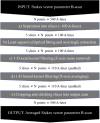Quantitative multi-contrast in vivo mouse imaging with polarization diversity optical coherence tomography and angiography
- PMID: 33408972
- PMCID: PMC7747897
- DOI: 10.1364/BOE.403209
Quantitative multi-contrast in vivo mouse imaging with polarization diversity optical coherence tomography and angiography
Abstract
Retinal microvasculature and the retinal pigment epithelium (RPE) play vital roles in maintaining the health and metabolic activity of the eye. Visualization of these retina structures is essential for pre-clinical studies of vision-robbing diseases, such as age-related macular degeneration (AMD). We have developed a quantitative multi-contrast polarization diversity OCT and angiography (QMC-PD-OCTA) system for imaging and visualizing pigment in the RPE using degree of polarization uniformity (DOPU), along with flow in the retinal capillaries using OCT angiography (OCTA). An adaptive DOPU averaging kernel was developed to increase quantifiable values from visual data, and QMC en face images permit simultaneous visualization of vessel location, depth, melanin region thickness, and mean DOPU values, allowing rapid identification and differentiation of disease symptoms. The retina of five different mice strains were measured in vivo, with results demonstrating potential for pre-clinical studies of retinal disorders.
© 2020 Optical Society of America under the terms of the OSA Open Access Publishing Agreement.
Conflict of interest statement
MVS: Seymour Vision (I). SM, YY: Yokogawa Electric Corp. (F), Nikon (F), Kao Corp. (F), Topcon (F), Tomey Corp (F, P), Sky Technology (F).
Figures










Similar articles
-
Melanin Pigmentation in Rat Eyes: In Vivo Imaging by Polarization-Sensitive Optical Coherence Tomography and Comparison to Histology.Invest Ophthalmol Vis Sci. 2015 Nov;56(12):7462-72. doi: 10.1167/iovs.15-17742. Invest Ophthalmol Vis Sci. 2015. PMID: 26595606
-
Multi-scale and -contrast sensorless adaptive optics optical coherence tomography.Quant Imaging Med Surg. 2019 May;9(5):757-768. doi: 10.21037/qims.2019.05.17. Quant Imaging Med Surg. 2019. PMID: 31281772 Free PMC article.
-
Retinal pigment epithelium hyperplasia overlying pigment epithelial detachment in age-related macular degeneration can masquerade as neovascularization on optical coherence tomography angiography.Graefes Arch Clin Exp Ophthalmol. 2018 Dec;256(12):2283-2291. doi: 10.1007/s00417-018-4138-y. Epub 2018 Sep 18. Graefes Arch Clin Exp Ophthalmol. 2018. PMID: 30229304 Free PMC article.
-
Practical guidance for imaging biomarkers in exudative age-related macular degeneration.Surv Ophthalmol. 2023 Jul-Aug;68(4):615-627. doi: 10.1016/j.survophthal.2023.02.004. Epub 2023 Feb 26. Surv Ophthalmol. 2023. PMID: 36854371 Review.
-
Optical coherence tomography angiography (OCTA) flow speed mapping technology for retinal diseases.Expert Rev Med Devices. 2018 Dec;15(12):875-882. doi: 10.1080/17434440.2018.1548932. Epub 2018 Nov 22. Expert Rev Med Devices. 2018. PMID: 30460869 Free PMC article. Review.
Cited by
-
Objective evaluation of choroidal melanin loss in patients with Vogt-Koyanagi-Harada disease using polarization-sensitive optical coherence tomography.Sci Rep. 2022 Mar 3;12(1):3526. doi: 10.1038/s41598-022-07591-9. Sci Rep. 2022. PMID: 35241784 Free PMC article.
-
Polarization-Diversity Optical Coherence Tomography Assessment of Choroidal Nevi.Invest Ophthalmol Vis Sci. 2023 Nov 1;64(14):6. doi: 10.1167/iovs.64.14.6. Invest Ophthalmol Vis Sci. 2023. PMID: 37930688 Free PMC article.
-
Granzyme B degrades extracellular matrix and promotes inflammation and choroidal neovascularization.Angiogenesis. 2024 Aug;27(3):351-373. doi: 10.1007/s10456-024-09909-9. Epub 2024 Mar 18. Angiogenesis. 2024. PMID: 38498232 Free PMC article.
-
Evaluation of choroidal melanin-containing tissue in healthy Japanese subjects by polarization-sensitive optical coherence tomography.Sci Rep. 2022 Mar 8;12(1):4048. doi: 10.1038/s41598-022-07818-9. Sci Rep. 2022. PMID: 35260673 Free PMC article.
-
Single-Shot Ultra-Widefield Polarization-Diversity Optical Coherence Tomography for Assessing Retinal and Choroidal Pathologies.J Clin Med. 2024 Sep 12;13(18):5415. doi: 10.3390/jcm13185415. J Clin Med. 2024. PMID: 39336902 Free PMC article.
References
-
- Huber G., Beck S. C., Grimm C., Sahaboglu-Tekgoz A., Paquet-Durand F., Wenzel A., Humphries P., Michael Redmond T., Seeliger M. W., Dominik Fischer M., “Spectral domain optical coherence tomography in mouse models of retinal degeneration,” Invest. Ophthalmol. Visual Sci. 50(12), 5888–5895 (2009). 10.1167/iovs.09-3724 - DOI - PMC - PubMed
-
- Zhang P., Zam A., Jian Y., Wang X., Li Y., Lam K. S., Burns M. E., Sarunic M. V., Pugh E. N., Zawadzki R. J., “In vivo wide-field multispectral scanning laser ophthalmoscopy–optical coherence tomography mouse retinal imager: longitudinal imaging of ganglion cells, microglia, and Müller glia, and mapping of the mouse retinal and choroidal vasculature,” J. Biomed. Opt. 20(12), 126005 (2015). 10.1117/1.JBO.20.12.126005 - DOI - PMC - PubMed
LinkOut - more resources
Full Text Sources
Research Materials
